And by that I mean everything!!! In D&D, nothing is safe!
Continue reading “Fantasy Safari: Everything is trying to kill you!”
Yora's site for Sword & Sorcery RPGs
And by that I mean everything!!! In D&D, nothing is safe!
Continue reading “Fantasy Safari: Everything is trying to kill you!”
I’ve been spending some more thoughts on undead in the Ancient Lands. Since there is only a single source of natural power and energy, anything that is unnatural is a corruption of it and also comes from the same source. Sorcery, demons, and undead are all really different forms of the same thing. In that context, I’ve been doing some reworking of the common undead types so that everything fits together seamlessly and makes all sense.
I particularly like the ghouls as being some kind of insane mutants. While they look more like diseased humans, they are actually a lot like Golum in most ways. The shadows are also cool. Usually they don’t really do anything and just stand around being creepy, but that means you can use them in much larger numbers and make them a type of dangerous environment.
 Ghouls are humans, elves, or other humanoids who have been corrupted by the dark magic of sorcery or demons. Though they have never truly died, they resemble the undead, existing in a state between life and death. They grow gaunt with pale skin and dark sunken eyes and are suffering from madness, but are also filled with unnatural vigor and are much more cunning than any beast. Their clawed fingers can crush a mans throat and leave deep rends in the flesh of their victims, and their teeth have the strength to bite through bones, as they regain their strength by feeding on the flesh of humans and beasts.
Ghouls are humans, elves, or other humanoids who have been corrupted by the dark magic of sorcery or demons. Though they have never truly died, they resemble the undead, existing in a state between life and death. They grow gaunt with pale skin and dark sunken eyes and are suffering from madness, but are also filled with unnatural vigor and are much more cunning than any beast. Their clawed fingers can crush a mans throat and leave deep rends in the flesh of their victims, and their teeth have the strength to bite through bones, as they regain their strength by feeding on the flesh of humans and beasts.
Many ghouls once were adventurers and treasure hunters who delved too deep into ancient places where the living are not meant to tread, or what remains of those who become slaves of dark sorcerers or demons.
Attributes
Strength 2
Agility 1
Mind -1
Appeal -2
Combat Abilities
Attack with bite or claw +2; damage 1d6-1 plus paralysis
Defense: 2
Protection: 1
Lifeblood: 10
Any character hit by a ghouls attack must make a Moderate Strength roll (+0/TN 9) or be paralysed for one hour.
No. Enc.: 1d6 (2d8)
Armor: 14
Move: Normal
Hit Dice: 2 (9 hp)
Attacks: Bite or claw
Damage: 1d4 plus paralysis
Save: F2
Morale: 9
A creature bit by a ghoul or hit by its claws must make a saving throw against paralysis or be paralysed for 2d8x10 minutes.
 When people die who have been corrupted by demonic sorcery, the Corruption that wrecked their bodies can linger on, turning into Shades. With both the bodies and souls of the original person gone, shades are nearly mindless clouds of Corruption that float silently above the spot where they died. They are normally invisible, but cast dark shadows in the presence of bright lights and they can be clearly seen as shapes of darkness if any light shines upon them in the presence of dust or smoke.
When people die who have been corrupted by demonic sorcery, the Corruption that wrecked their bodies can linger on, turning into Shades. With both the bodies and souls of the original person gone, shades are nearly mindless clouds of Corruption that float silently above the spot where they died. They are normally invisible, but cast dark shadows in the presence of bright lights and they can be clearly seen as shapes of darkness if any light shines upon them in the presence of dust or smoke.
Walking through a shade drains a small part of the life force of living creatures and can start the spreading of Corruption over time. While most shades stand motionless in the spot of their death and don’t seem to react to anything around them, some are aware of the presence of living beings nearby and attack when anything comes too close to them. While their insubstential clawn do not leave any physical injuries, being in prolonged contact with an attacking shade can quickly drain all the life energy of a living person and spread the Corruption through its body. People who survive the attack of a shade often show dark purple streaks on their skin that becomes ashen pale and cold, which will last for several days. Those who die will often leave behind a shade as well, joining those who killed them.
Shades are common in places where lots of people have been killed through sorcery, like the lairs of demons or the sites of sorcerous battles.
Attributes
Strength –
Agility 3
Mind -3
Combat Abilities
Attack with touch +3; damage 1d6-1
Defense: 3
Protection: 0
Lifeblood: 5 (only harmed by magic)
When a creature is killed by a shade, a new shade appears in the spot of its death 3 rounds later.
No. Enc.: 1d6 (2d10)
Armor: 15
Move: Normal
Hit Dice: 2 (9 hp)
Attacks: Touch
Damage: 1d4
Save: F2
Morale: 12
Shades can only be harmed by magic weapons or spells. Any living creature killed by a shade must make a saving throw against Death or Poison or a new shade will appear where it died within 1d4 rounds.
Petty Gods is a book of about 300 minor deities and 100 monsters connected to them, which has been released this month and is entirely free for download. It’s the work of probably about a hundred different contributors, with most simply having contributed one or two gods or an illustration.
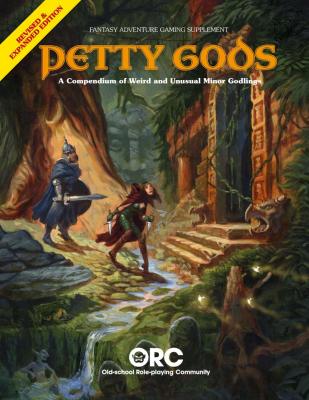 That sounded really interesting to me, as I always love to see an approach to religion in RPGs that is more animistic and dealing with minor spirits instead of continent spanning hierarchical churches. So I gave it a look.
That sounded really interesting to me, as I always love to see an approach to religion in RPGs that is more animistic and dealing with minor spirits instead of continent spanning hierarchical churches. So I gave it a look.
And I have to say I am deeply disappointed. I don’t know what exactly I expected, but from the cover it was very clearly not this. Basically, all the 300 gods are jokes. You got such things as the god of coin debasement, a god of old string, the goddess of dumping corpses under a bridge at night, and about a dozen gods of crossroads. Is this book meant to be a parody? If so, I don’t find it funny at all. If this is an attempt at something serious, it’s a complete failure. If it’s meant as a nostalgic tribute to early D&D, I am not feeling it either.
I have nothing against a bit of silliness in fantasy and RPGs. Many of my favorite works are greatly overstretching any sense of plausibility and two of my favorite words in any language are ludicrous and preposterous. But even the most over the top Sword & Sorcery or Pulp Adventure at the very least takes itself serious and actually means to tell a genuinely exciting story with great themes. But this is not laughing with the genre, this is laughing about the genre. And I don’t find it funny at all.

The one good thing I can say about it is a ten page article by M.A.R. Barker in the appendix, which is about creating religion in realistic fantasy settings. Unfortunately, the good man had been dead for three years when this book was released. If he had had a chance to contribute directly to its creation, it might have turned out a lot better. Or perhaps the article should have been given to the other contributors before they wrote this nonsense.
Since its free, I can just easily delete the file and try to forget this wasted hour of my life, but if you would have to pay for this, I would consider this an exceptionally terrible book. Really can’t recommend it at all to anyone.
The Moatia are a race of short old men with yellow skin who walk with a limping gait. All of them are powerful sorcerers who live alone deep within the forests and warn away any intruders with markposts made from bones. They are often wicked and cruel, but are also very skilled healers who have medicine and powders to cure any ailment in existance. They never provide services for free though, and the prices they demand can be very steep or appaling. Moatia don’t use any weapons or attack with their hands, but fight entirely with their magic. They remind me quite a lot of central European witches in their behavior and role.
The Night Men are a race of humans from outside the Three Lands, but all of them are savage and deformed, but almost nothing is known about them other than that they sometimes cross the river at night and raid villages on the southern border. When they attack, they always do so in large hordes, and are usually led by a very powerful sorcerer or shaman. These raiders destroy villages and take large numbers of captives, which they take back to their jungles to be sacrificed in ancient ruined temples. Some people think that they are evil spirits or actually animals that have been transformed into human-like shapes.
The Obia is a spirit in the shape of a large leopard or jackal that serves sorcerers and witches as a guardian or to abduct people and bring them to them. Either to become their wives or for other unspeakable purposes. An obia can grasp a victims in its mouth without hurting them and then run off into the night at very great speed leaving barely any traces. Only the greatest hunters have any chance of tracking them down and find the place where the victims are held. Defeating the sorcerer and his obia guardian is a whole different story altogether.
Continue reading “Fantasy Safari: Spears of the Dawn, Part 2”
I reviewed Spears of the Dawn a few weeks ago, and it’s a nice little setting I recommend to anyone with interest in non-European influenced fantasy campaigns. I also really love the new classes and magic system based on Basic D&D that work much better for spellcasters in a Sword & Sorcery setting than standard clerics and wizards. But in addition to all that, Spears of the Dawn also has a short and very nice collection of monsters, which made me want to make another Fantasy Safari post.
As part of the funding campaign, all the art from the book was given away freely, which is always very nice when doing this series.
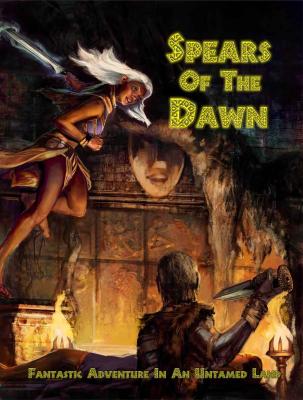
Spears of the Dawn by Sine Nomine Publishing, 2013; 11 pages of monsters.
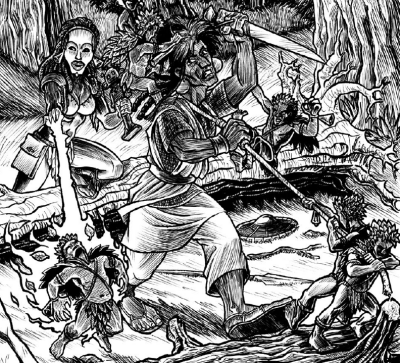
Eloko are a race of tiny people who look just like humans but have grass instead of hair and wear clothes made from leafs. However, there is nothing endearing about these little guys, as they like to eat humans. Lone hunters are a welcome meal for groups of eloko, but they have a particular taste for the flesh of women. Before they reveal themselves to their prey, they make their presence known by the ringing of tiny bells, which have the ability to cloud the thoughts of any human to the point where they will simply stand around motionless while being devoured alive. If someone can resist the mind numbning ringing of their small bells, eloko are still much more dangerous than their small size makes them look and a single one fights about as well as a fully grown crocodile. In groups they can be a real threat to small parties of adventurers.
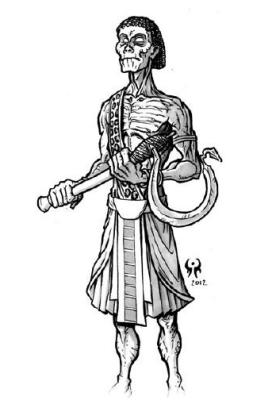
The Eternal are probably my favorite monster of Spears of the Dawn and the major antagonists of the setting. When their evil kingdom was facing defeat by the five other realms of the Three Lands, they turned to dark magic to make themselves immortal. After their death, a magic ritual made their bodies return to a state of unlife, where they need to neither eat, drink, sleep, or even breath. Nor do they bleed and they are impossibly to truly destroy. Stabbing wounds don’t harm them at all and the only way to really harm them is to break their bones or chop off their limbs. While they are able to exist deep in the deserts or underground without any food or water forever and can not be killed by weapons, their unliving nature also makes them unable to heal as they are still corpses. The only way to restore their mangled bodies after suffering the effects of injuries, blasting sand, and the blazing sun is to feed on human flesh. And that already tells you pretty much everything you need to know to understand why they are such a terrifying menace on the Three Lands. They are a lot like vampires in many ways, but also distinctively different creatures. They do not have to feed on humans, but if they do not the ravages of time and the environment quickly take a heavy toll on their dead flesh. They are not harmed by sunlight and in fact nothing can really destroy them. The only way to deal with them permanently is to decapitate them so they are unable to feed and heal their injuries, but even when burned to ash and their bones are ground to dust, their immortal spirits remain, unable to gain a new body or truly die. And like vampires, many eternal sorcerers know the old rituals and can raise the corpses of their enemies to be their slaves forever. Spears of the Dawn is an interesting setting in itself, but the Eternal are what really is selling it to me. They are somewhat similar to an idea I had for my Ancient Lands settings, and I got a whole number of new ideas I want to include from the Eternal. Continue reading “Fantasy Safari: Spears of the Dawn, Part 1.”
Black Streams is a series of free, short supplements for the Red Tide campaign sertting by Kevin Crawford. Though they are directly tied to the setting, they are self contained enough to be eassily adapted for any setting in any OSR game and should also be useful sources of ideas for other systems.
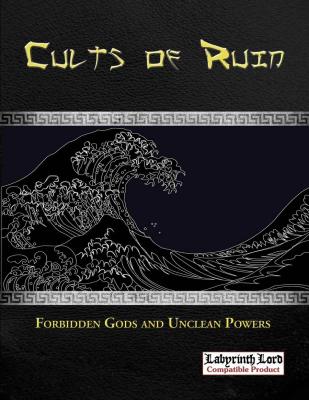 Cults of Ruin expands on the cults of various evil forces that are mentioned in Red Tide and has a length of 7 pages. The Black Emperor was a powerful and evil ruler back in the days before the Tide, who was eventually destroyed for his dark sorcery, but somehow managed to ascend to becoming a god. Though most records of his terrible reign and evil transgressions had been deliberately destroyed or lost during the coming of the Red Tide, the truth can still sometimes be discovered by sages searching for obscure lore. Only scholars, alchemists, and other learned people can become true followers of the Black Emperor, who offers them secrets to extend their life and evade Hell and other necromantic magic. The God-Beasts are savage animal spirits that protect remote villages and can grant fertility to their fields and herds, but often demand terrible forms of tribute from their worshippers. The only salvation offered by the Hell Kings is the promise that those people who truly devote themselves to evil can gain their respect and admiration, so that when they ultimately will go to Hell after their death, they will be elevated to rank among the Hell Kings instead of suffering in eternal agony. Worshippers of the Hell Kings are expected to lead as many souls as possible into hell, but even among the high priests of the cults only very few reach a degree of evil that gets them a place among the lowest ranks of devils. The Red Gods are strange entities of evil and hunger that only reveal themselves to people suffering from famine and facing starvation. They grant the gift of great strength and vigor, but in turn those who accept it slowly transform into ravenous beasts who gain sustenance from a range of unnatural and depraved sources. Finally there are the truly mad cults that worship the Red Tide itself. They are compelled to create portals that allow the Tide to spill into the Sunset Isles and are usually the first to be torn apart by the horde of the Tides spawn that emerges. The last page describes the new Azure Minister class, a cleric variant specialized in secretly exterminating evil cults that threaten the Sunset Isles while keeping the existance and true nature of their organization secret.
Cults of Ruin expands on the cults of various evil forces that are mentioned in Red Tide and has a length of 7 pages. The Black Emperor was a powerful and evil ruler back in the days before the Tide, who was eventually destroyed for his dark sorcery, but somehow managed to ascend to becoming a god. Though most records of his terrible reign and evil transgressions had been deliberately destroyed or lost during the coming of the Red Tide, the truth can still sometimes be discovered by sages searching for obscure lore. Only scholars, alchemists, and other learned people can become true followers of the Black Emperor, who offers them secrets to extend their life and evade Hell and other necromantic magic. The God-Beasts are savage animal spirits that protect remote villages and can grant fertility to their fields and herds, but often demand terrible forms of tribute from their worshippers. The only salvation offered by the Hell Kings is the promise that those people who truly devote themselves to evil can gain their respect and admiration, so that when they ultimately will go to Hell after their death, they will be elevated to rank among the Hell Kings instead of suffering in eternal agony. Worshippers of the Hell Kings are expected to lead as many souls as possible into hell, but even among the high priests of the cults only very few reach a degree of evil that gets them a place among the lowest ranks of devils. The Red Gods are strange entities of evil and hunger that only reveal themselves to people suffering from famine and facing starvation. They grant the gift of great strength and vigor, but in turn those who accept it slowly transform into ravenous beasts who gain sustenance from a range of unnatural and depraved sources. Finally there are the truly mad cults that worship the Red Tide itself. They are compelled to create portals that allow the Tide to spill into the Sunset Isles and are usually the first to be torn apart by the horde of the Tides spawn that emerges. The last page describes the new Azure Minister class, a cleric variant specialized in secretly exterminating evil cults that threaten the Sunset Isles while keeping the existance and true nature of their organization secret.
The Pacts of the Wise seems to be heavily inspired by pact magic from the Tome of Magic of Dungeons & Dragons. It’s 7 pages long and describes six elusive entities that can be contacted by a wizard to be granted special powers. The ritual to make a pact take a month of preparation and have to be repeated once every year. Unless a ritual to be released from the pact is performed, wizards who fail to meet their obligations are suffering severe consequences until their debts are paid. The powers granted by the entities are not particularly powerful and more than balanced by the price demanded from the wizard, but still interesting and useful enough that players might consider it to be worth it. It certainly adds an interesting new element to the character and each pact includes ideas on how to create adventures around NPCs who have access to these powers or are struggling with meeting their part of the bargain and are getting desperate to gain the required resources. Even though there are only six entities described, they provide a sufficient base to create your own ones. Since the mechanics involved are extremely simply they are easily adapted to any game.
The Yellow Legion is 8 pages long and describes a powerful artifact and the Walking Ghosts it can create, as well as their history in the Red Tide setting. The artifact is a black rod that can be planted into the ground to grow into a large tree that produces magic fruit when watered with the blood of living people. The juice of the fruit have the power to restore any corpse and return it to unlife, and the blood of a single person creates enough fruit to create ten walking ghosts. However, the fruit can only revive creatures of the same type of creature whose blood is used to create them, so to bring a fallen army of human soldiers back to life, many humans have to be sacrificed to the trees. While those who have been sacrificed can be raised like any other corpse, they are henceforth forced to exist as undead. The walking ghost are loyal to the person who create the tree and appear just as they were in life. They do not eat, drink, breath, or sleep and they heal and can be healed like living humans, but even the terrible and horrific wounds can not kill them. Only when hacked to pieces or burned do their minds fall into delirious slumber, but over the course of many years their bodies can restore themselves and make the walking ghosta rise from their graves. Without purpose after the eventual death of their creator they wander the land with the appearance of a living person, but all living things can sense their unnatural aura. If there is a way to permanently end them, it has not been discovered.
Though short as they are, I really like all these supplements and in fact their briefness probably makes them even more interesting and useful for GMs not using the Red Tide setting. Pacts of the Wise is probably the most versatile and not at all connected to any specific settin, and I recommend it to everyone to give it a look. The other two have a much more specific cultural flavor, but since they are both short and completely free, I do recommend them all. Really nice stuff and a format I would like to see used by more games in addition to full sized books.